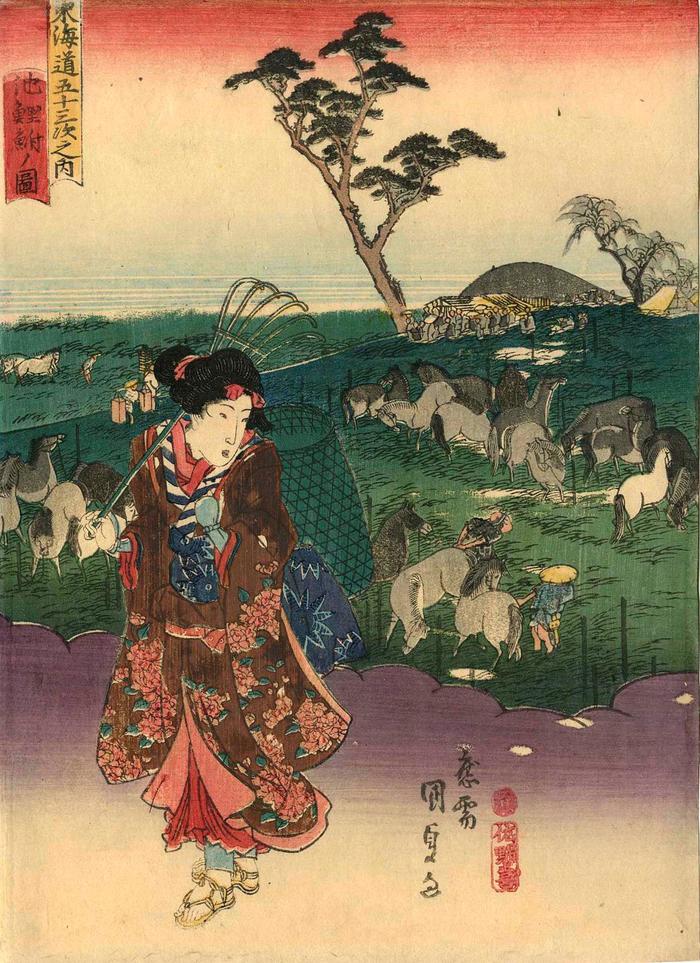Utagawa Kunisada (歌川国貞) / Toyokuni III (三代豊国) (artist 1786 – 01/12/1865)
View of Chiryū (Chiryū no zu: 池鯉鮒ノ図) from the chuban series Fifty-three Stations of the Tōkaidō Road (Tōkaidō gojūsan tsugi no uchi: 東海道五十三次之内)
ca 1838
Signed: ōju Kunisada ga (応需国貞画)
Publisher: Sanoya Kihei
Censor's seal: kiwame
Museum of Fine Arts, Boston
National Diet Library
Spencer Museum of Art
Museum für angewandte Kunst, Vienna
British Museum - Hiroshige's version 'Chiryu shuka uma-ichi'
Virginia Museum of Fine Art - in black and white
Ishikawa Prefectural Museum of Art - they date their copy to 1836
Bryn Mawr
Honolulu Museum of Art
Google maps - Chiryū
Berkeley Art Museum and Pacific Film Archive, the University of California This is number 40 of this series.
****
Sebastian Izzard in Hiroshige: an exhibition of selected prints and illustrated books on page 26 points out the crowd of farmers and horse-traders in the distance gathered before the market stalls. Kunisada kept this element of the original Hiroshige print. However, it should be noted that there are two versions of this Hiroshige print. One with the mound-like mountain in the background and one where it has been removed. Kunisada's follows the earlier one.
****
Gian Carlo Calza in his description in Hiroshige: The Master of Nature of the original Hiroshige print re-imagined in this scene said: "It is improbable that Hiroshige actually had the opportunity to witness the annual horse fair in Chiryū, which would have ended quite some time before he passed through. And he probably would not have seen the great fields of irises, which were another reason for the fame of this place. But regardless of this, he has created a masterful composition with a broad spatial expanse interrupted only by the large tree in the centre and the prospective customers gathered underneath. The infinite lines of tall grass are contrasted with the soft rounded ones of the horses on show. The grooms watch over them and lead them to potential buyers. In their movements and gestures we see the same naturalness as that reflected in the animals they care for."
****
In Tokaido Landscapes: The Path from Hiroshige to Contemporary Artists, 2011, #40, p. 52, speaking of the original Hiroshige print it says in a text by Sasaki Moritoshi: "The market in the subtitle was alarge horse market that took place in Chiryū from April 25 to May 5 on the lunar calendar."
****
Muneshige Narazaki in Masterworks of Ukiyo-e: Hiroshige, the 53 Stations of the Tōkaidō (p. 71) notes: "Hiroshige could not actually have seen the fair, since it was held before his arrival; nor could he have seen Chiryū's Eight Bridges, so often painted and written about in older days (in "The tales of Ise" in particular), for they had already fallen into ruin; but he might have seen Chiryū's third claim to fame - its beautiful irises (also mentioned in "The Tales of Ise").
****
Illustrated:
1) in a full-page color reproduction in Japanese Woodblock Prints: Artists, Publishers and Masterworks 1680-1900 by Andreas Marks, Tuttle Publishing, 2010, page 246.
2) in a small color reproduction in Kunisada's Tokaido: Riddles in Japanese Woodblock Prints by Andreas Marks, Hotei Publishing, 2013, page 72, T24-40.
Sanoya Kihei (佐野屋喜兵衛) (publisher)
landscape prints (fūkeiga 風景画) (genre)
